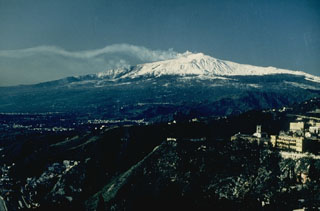Report on Etna (Italy) — 26 February-4 March 2025
Smithsonian Institution / US Geological Survey
Weekly Volcanic Activity Report, 26 February-4 March 2025
Managing Editor: Sally Sennert.
Please cite this report as:
Global Volcanism Program, 2025. Report on Etna (Italy) (Sennert, S, ed.). Weekly Volcanic Activity Report, 26 February-4 March 2025. Smithsonian Institution and US Geological Survey.
Etna
Italy
37.748°N, 14.999°E; summit elev. 3357 m
All times are local (unless otherwise noted)
The Sezione di Catania - Osservatorio Etneo (INGV) reported that an eruption at Etna continued during 24 February-2 March. Activity observed through webcams and during field inspections on 28 February and 2 March was characterized by the effusion of lava flows from at least four vents, Strombolian activity at the summit, and gas emissions at several of the summit craters. Strombolian activity at SE Crater stopped on 25 February and the effusion rate at the fissure on the upper S flank of Bocca Nuova Crater decreased significantly. On 27 February Strombolian activity resumed at SE Crater and lava effusion increased at Bocca Nuova Crater. Lava overflowed the SE Crater on 28 February. That same day several new features on the upper S flank of Bocca Nuova Crater were identified in drone images. Several small cracks partly surrounding a 150-m-long, oval depression, oriented NE-SW, was located just upflank of the eruptive fissure. At a higher elevation than the depression was a vent that produced a yellow fumarolic plume. Thermally anomalous areas were located about 100 m both to the E and W of the depression. The lava-flow fronts were most active at an elevation of 2,750 m. Strombolian activity at SE Crater ceased during the evening of 28 February. Lava effusion at the Bocca Nuova vent continued during 1-2 March at a low rate.
Geological Summary. Mount Etna, towering above Catania on the island of Sicily, has one of the world's longest documented records of volcanism, dating back to 1500 BCE. Historical lava flows of basaltic composition cover much of the surface of this massive volcano, whose edifice is the highest and most voluminous in Italy. The Mongibello stratovolcano, truncated by several small calderas, was constructed during the late Pleistocene and Holocene over an older shield volcano. The most prominent morphological feature of Etna is the Valle del Bove, a 5 x 10 km caldera open to the east. Two styles of eruptive activity typically occur, sometimes simultaneously. Persistent explosive eruptions, sometimes with minor lava emissions, take place from one or more summit craters. Flank vents, typically with higher effusion rates, are less frequently active and originate from fissures that open progressively downward from near the summit (usually accompanied by Strombolian eruptions at the upper end). Cinder cones are commonly constructed over the vents of lower-flank lava flows. Lava flows extend to the foot of the volcano on all sides and have reached the sea over a broad area on the SE flank.

